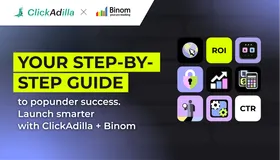
Click-fraud is a serious problem resulting in negative consequences for several spheres of your business at once. To save your budgets we prepared an article about click-fraud and tips to withstand it.
Quick navigation ⤵️
▶ The Relevance of Click-fraud
▶ What is Click-fraud?
▶ Effects of click-fraud
▶ Tips and tools to protect
▶ Special Recommendation
The Relevance of Click-fraud
Nowadays among all possible options pay-per-click advertising has proved to be the most effective in digital marketing. On the flip side of the coin, advertising may also turn out to be the cause of losing budgets and customers for many companies.
Unfortunately, no company is protected from click-fraud, regardless of its size or the budget allocated for advertising expenses. However, there are some methods that may help to avoid click-fraud. So, today we will discuss what click-fraud is, who may be interested in it and how to lower chances of facing it
What is Click-fraud?
It is a fraudulent activity in pay-per-click advertisements aimed to devastate the budget of the company the ad belongs to. The purpose is to repeatedly click on a pay-per-click ad without buying or even viewing the product, so that the advertiser has to pay for the clicks.
Clickbots
The click bot behaves like a browser, but usually has relatively limited functionality. For example, a bot may not be able to analyze all elements of HTML pages, execute JavaScript scripts, or apply CSS. Thus, a clickbot is created as a simple malware embedded in the victim's computer. Even if we assume that a complex click bot will get features close to a real browser, its real behavior when connecting to the advertised site will still differ from the real user. This is due to the fact that clickbots are automated programs and are not smart enough to see, think and behave like humans.
A typical clickbot performs some common functions, including initiating HTTP requests to a web server, tracking redirects, and retrieving content from a web server. However, it does not have the ability to commit click fraud by itself, so it acts as a relay based on instructions from a remote botmaster. The Bot Master can manage millions of clickbots to perform automatic and large-scale attacks.
Clickers
Clickers are people who are hired for money to click on targeted advertisements. Human clickers have a financial incentive to click on ads as quickly as possible, which distinguishes them from real users who are really interested in the advertised products. For example, a real user is more likely to read descriptions, look at images, think and walk around the site to learn about the product before buying. A paid clicker has no such interest, and therefore he will quickly get bored and spend less time on the site.
Advertisers
Advertisers are in an advantageous position — they can observe and further identify all fraudulent actions committed by clickbots and clickers. To complete click fraud, all fraudulent HTTP requests must be directed to the advertised website, regardless of how many intermediate redirects and parties are involved along the way. This indicates that both clickbots and clickers should eventually turn to the victim. Thus, advertisers have an advantage in detecting clickbots and human clickers in the process of communication. In addition, it is advertisers who lose money, which means they have the strongest motivation to counteract click fraud.
Effects of click-fraud
However, devastation of the budget is not the only problem caused by click-fraud:
- an increase in advertising costs
- inaccurate user data
- low or none conversions
- not effective management decisions (since the marketing data has been distorted)
That may lead to an absolutely incorrect strategy in the future. Moreover, due to the click-fraud, marketing campaigns may quickly reach the daily limit of expenses and the advertising will not be shown to actual users. As a result, your competitor's ads will take the place of yours.
Thus, click-fraud is a serious problem resulting in negative consequences for several spheres of your business at once.
Tips and tools to protect

1. Observe user behavior
Tracking clicks on ads is a great way to detect fraud. You can monitor whether suspicious clicks are coming from the same internet provider to see if they should be considered suspicious.
2. Use applications to create reports on traffic sources
Find out about traffic sources using the appropriate applications. These tools will help you find out if your site receives a suspicious number of visitors from any content-oriented site.
3. Set flexible advertising prices
When setting prices for your ads, make sure that you specify different prices on different sites. This way you can limit future costs per ad.
4. Keep an eye on your competitors
Aren't your competitors trying to ruin you? You can get an answer to this question by using various tools for generating reports on the number of unique clicks and on the total number of clicks.
5. Use the software to protect against ad clipping
In addition to the methods mentioned above, you may also use anti-click-fraud software to detect suspicious or dangerous activity and automatically block traffic sources.
Special Recommendation
JavaScript support and mouse event test
One easy way to detect a click bot is to check whether the client supports JavaScript or not. This is due to the fact that at least 98% of web browsers support JavaScript, and online advertising services usually rely on JavaScript support.
Mouse event monitoring is another effective way to detect scammers. In general, a reasonable user with a laptop/desktop computer should generate at least one event when viewing a website. The absence of mouse events classifies the client as a click bot. However, this may not be the case for users of mobile platforms (smartphones/tablets). Thus, it is recommended to apply the mouse event test only for desktop platform users.
In order to identify scammers, you may additionally determine whether your ads and the sites on which they are advertised are actually visible to users. To do this, you can use the new features provided by some advertising networks. They allow advertisers to embed JavaScript code into their ads to better understand what is happening with the client-side advertising. With these functions, you may determine whether our advertising frame is visible on the user's screen or it is loaded in the background, whether the focus is really on it and whether it is pressed.
ClickAdilla is paying a lot of attention to the effectiveness and safety of ad campaigns. We prevent bot traffic with our in-house anti-fraud system and carefully check all premium publishers’ websites in our Ad Network.
With ClickAdilla you may be confident in your ad campaigns safety. Do not hesitate to start!





